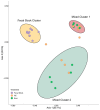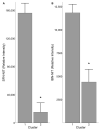Composition of the Gut Microbiome Influences Production of Sulforaphane-Nitrile and Iberin-Nitrile from Glucosinolates in Broccoli Sprouts
- PMID: 34578891
- PMCID: PMC8468500
- DOI: 10.3390/nu13093013
Composition of the Gut Microbiome Influences Production of Sulforaphane-Nitrile and Iberin-Nitrile from Glucosinolates in Broccoli Sprouts
Abstract
Isothiocyanates, such as sulforaphane and iberin, derived from glucosinolates (GLS) in cruciferous vegetables, are known to prevent and suppress cancer development. GLS can also be converted by bacteria to biologically inert nitriles, such as sulforaphane-nitrile (SFN-NIT) and iberin-nitrile (IBN-NIT), but the role of the gut microbiome in this process is relatively undescribed and SFN-NIT excretion in humans is unknown. An ex vivo fecal incubation model with in vitro digested broccoli sprouts and 16S sequencing was utilized to explore the role of the gut microbiome in SFN- and IBN-NIT production. SFN-NIT excretion was measured among human subjects following broccoli sprout consumption. The fecal culture model showed high inter-individual variability in nitrile production and identified two sub-populations of microbial communities among the fecal cultures, which coincided with a differing abundance of nitriles. The Clostridiaceae family was associated with high levels, while individuals with a low abundance of nitriles were more enriched with taxa from the Enterobacteriaceae family. High levels of inter-individual variation in urine SFN-NIT levels were also observed, with peak excretion of SFN-NIT at 24 h post broccoli sprout consumption. These results suggest that nitrile production from broccoli, as opposed to isothiocyanates, could be influenced by gut microbiome composition, potentially lowering efficacy of cruciferous vegetable interventions.
Keywords: bacteria; glucosinolate; iberin; iberin-nitrile; isothiocyanate; microbiome; sulforaphane; sulforaphane-nitrile.
Conflict of interest statement
The authors declare no conflict of interest.
Figures




Similar articles
-
Sulforaphane and Sulforaphane-Nitrile Metabolism in Humans Following Broccoli Sprout Consumption: Inter-individual Variation, Association with Gut Microbiome Composition, and Differential Bioactivity.Mol Nutr Food Res. 2024 Feb;68(4):e2300286. doi: 10.1002/mnfr.202300286. Epub 2023 Dec 24. Mol Nutr Food Res. 2024. PMID: 38143283 Free PMC article.
-
Metabolic Fate of Dietary Glucosinolates and Their Metabolites: A Role for the Microbiome.Front Nutr. 2021 Sep 22;8:748433. doi: 10.3389/fnut.2021.748433. eCollection 2021. Front Nutr. 2021. PMID: 34631775 Free PMC article. Review.
-
The metabolism of methylsulfinylalkyl- and methylthioalkyl-glucosinolates by a selection of human gut bacteria.Mol Nutr Food Res. 2014 Apr;58(4):875-83. doi: 10.1002/mnfr.201300377. Epub 2013 Oct 30. Mol Nutr Food Res. 2014. PMID: 24170324
-
Comparison of isothiocyanate metabolite levels and histone deacetylase activity in human subjects consuming broccoli sprouts or broccoli supplement.J Agric Food Chem. 2011 Oct 26;59(20):10955-63. doi: 10.1021/jf202887c. Epub 2011 Sep 30. J Agric Food Chem. 2011. PMID: 21928849 Free PMC article.
-
Formation, immunomodulatory activities, and enhancement of glucosinolates and sulforaphane in broccoli sprouts: a review for maximizing the health benefits to human.Crit Rev Food Sci Nutr. 2024;64(20):7118-7148. doi: 10.1080/10408398.2023.2181311. Epub 2023 Feb 27. Crit Rev Food Sci Nutr. 2024. PMID: 36847125 Review.
Cited by
-
Is Bitterness Only a Taste? The Expanding Area of Health Benefits of Brassica Vegetables and Potential for Bitter Taste Receptors to Support Health Benefits.Nutrients. 2022 Mar 30;14(7):1434. doi: 10.3390/nu14071434. Nutrients. 2022. PMID: 35406047 Free PMC article. Review.
-
Sulforaphane and Sulforaphane-Nitrile Metabolism in Humans Following Broccoli Sprout Consumption: Inter-individual Variation, Association with Gut Microbiome Composition, and Differential Bioactivity.Mol Nutr Food Res. 2024 Feb;68(4):e2300286. doi: 10.1002/mnfr.202300286. Epub 2023 Dec 24. Mol Nutr Food Res. 2024. PMID: 38143283 Free PMC article.
-
Glucosinolate Diversity Analysis in Choy Sum (Brassica rapa subsp. chinensis var. parachinensis) Germplasms for Functional Food Breeding.Foods. 2023 Jun 16;12(12):2400. doi: 10.3390/foods12122400. Foods. 2023. PMID: 37372611 Free PMC article.
-
Sulforaphane Bioavailability in Healthy Subjects Fed a Single Serving of Fresh Broccoli Microgreens.Foods. 2023 Oct 15;12(20):3784. doi: 10.3390/foods12203784. Foods. 2023. PMID: 37893677 Free PMC article.
-
Angioprevention of Urologic Cancers by Plant-Derived Foods.Pharmaceutics. 2022 Jan 21;14(2):256. doi: 10.3390/pharmaceutics14020256. Pharmaceutics. 2022. PMID: 35213989 Free PMC article. Review.
References
-
- Angelino D., Jeffery E. Glucosinolate Hydrolysis and Bioavailability of Resulting Isothiocyanates: Focus on Glucoraphanin. J. Funct. Foods. 2014;7:67–76. doi: 10.1016/j.jff.2013.09.029. - DOI
-
- Verkerk R., Schreiner M., Krumbein A., Ciska E., Holst B., Rowland I., Schrijver R.D., Hansen M., Gerhäuser C., Mithen R., et al. Glucosinolates in Brassica Vegetables: The Influence of the Food Supply Chain on Intake, Bioavailability and Human Health. Mol. Nutr. Food Res. 2009;53:S219. doi: 10.1002/mnfr.200800065. - DOI - PubMed
MeSH terms
Substances
Grants and funding
LinkOut - more resources
Full Text Sources
Research Materials
Miscellaneous

